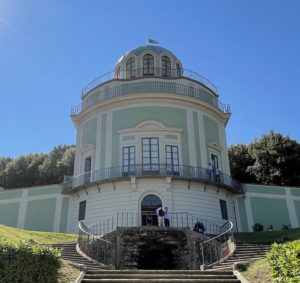The Rebirth of the Boboli Gardens

The renovation of Kaffeehaus is nearing completion, and in fall 2022, this important building inside the Boboli Garden complex is slated to open to visitors.
Work at the historic Kaffeehaus included the restoration of the 18th century frescoes and the installation of a new air conditioning and lighting system. The former Grand Ducal café, after years of closure, which will be be inaugurated in October, is now equipped with a counter, tables inside and outside, rest rooms, a large garden, and a panoramic terrace overlooking a breathtaking panorama of Florence.
The Boboli Gardens were once the ruling Medici family’s backyard and private park. In 1569, Cosimo I de’ Medici was crowned Grand Duke, the immediate sequel to Florence’s conquest of Siena, which was the obstacle in the creation of a unified territory. The Grand Duchy of Tuscany was then given equal status with other European states. When the Medici dynasty became extinct in the 1700s, rule of the Grand Duchy passed to their heirs, the Hapsburg Lorraine family, who ruled until the unification of Italy in the 1861.
Several other restoration projects have recently been completed in Boboli Gardens, for which more than 2,400,000 euros were allocated. The works comprise the installation of new signage to clarify the path routes; the restoration of the Fontana delle Scimmie; the renovation of the first part of the Giardino dei Principini, the introduction of an innovative video surveillance system at the Pagliere through the redevelopment and renovation of the entrance to piazza della Calza and the Garden of the Camellias. The Pagliere will also be modernized and turned into a visitor’s center.
In the Garden of the Camellias, a structural consolidation of the walls was necessary in addition to an extensive restoration of the sculptures and murals in the grottoes. In addition, a new irrigation system was built to water the 39 varieties of camellias present and a lighting system was added in order to be able to host events in the evenings.
FUTURE PLANS: BOBOLI 2030
With over 33 hectares (over 4 million acres) filled with history, art, and nature, the Boboli Gardens represents one of the first and most important examples of Italian gardens which inspired many European gardens like the one in Versailles. Filled with monuments and adorned with caves and fountains, the park will experience ongoing restoration with a budget of over 50 million euros.
The recently unveiled master plan, Boboli 2030, includes the complete restoration of sculptures and fountains, optimization of water resources, opening of new spaces, designing a new lighting and video surveillance system, and conversion of buildings with brand new services for residents.
The idea behind the mega-project is to bring the Boboli back to the glories of the Medici and Lorraine eras and to make the open-air museum more accessible and environmentally sustainable.
The main interventions of the Boboli 2030 project will be the complete restoration of the Amphitheater and the adjacent garden (€4,000,000); the architectural, sculptural, and landscaping renovation of Prato delle Colonne including the construction of a new water system (€1,400,000); securing the surrounding walls; the reinforcement of the walls and gates of the Royal Stables Monumental Park (€1,400,000); the clearing of the path that leads from Sughera to Lavacapo (€3,000,000); and the construction of a new and expanded photography archive with ample space for the public (€1,000,000).
The future projects also include the renovation of the Palazzina di Giove and della Vecchia: a large restoration laboratory of 142 square meters (€200,000) and 60 square meters of new offices for the botany department and a changing rooms for gardeners at La Vecchia (€36,000). The installation of elevators, and restoration of the Mula, the Torre del Mascherino (€280,000), and the Mostaccini fountain (€35,000) are also being planned.
In total, the cost of the 40 projects is approximately 40 million euros, with additional 12 million euros for the ordinary and extraordinary maintenance of the park. (elif aytemiz)
